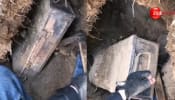Zeenews Bureau
New Delhi: NASA’s Dawn spacecraft on Wednesday began its two-and-a-half-year journey to the dwarf planet Ceres.
It is the first probe to orbit and study two distant solar system destinations to help scientists answer questions about the formation of our solar system.
Ground controllers received a signal from Dawn that it successfully spiraled away from the asteroid Vesta and was headed toward the dwarf planet Ceres.
The departure was considered ho-hum compared with other recent missions — think Curiosity`s white-knuckle "seven minutes of terror" dive into Mars` atmosphere. Firing its ion propulsion thrusters, Dawn gently freed itself from Vesta`s gravitational hold Tuesday night. Since its antenna was pointed away from Earth during the maneuver, NASA did not get confirmation until the next day.
It was "smooth and elegant and graceful," said chief engineer Marc Rayman of the NASA Jet Propulsion Laboratory, which manages the $466 million mission.
Launched in 2007, Dawn is on track to become the first spacecraft to rendezvous with two celestial bodies in a bid to learn about the solar system`s evolution.
Dawn slipped into orbit last year around Vesta — about the size of Arizona — and beamed back stunning close-ups of the lumpy surface. Its next destination is the Texas-size Ceres.
Vesta and Ceres are the largest bodies in the asteroid belt between Mars and Jupiter that`s littered with space rocks that never quite bloomed into full-fledged planets. As cosmic time capsules, they`re ideal for scientists trying to piece together how Earth and the other planets formed and evolved.
During its yearlong stay at Vesta, Dawn used its cameras, infrared spectrometer, and gamma ray and neutron detector to explore the asteroid from varying altitudes, getting as close as 130 miles above the surface.
Dawn uncovered a few surprises. Scientists have long known that Vesta sports an impressive scar at its south pole, likely carved by an impact with a smaller asteroid. A closer inspection revealed that Vesta hid a second scar in the same region — evidence that it had been whacked twice within the last 2 billion years.
The collisions spewed chunks of debris into space; some fell to Earth as meteorites.
With its rugged exterior — complete with grooves, troughs and pristine minerals — and iron core, Vesta acts more like an "almost planet" than garden-variety, lightweight asteroids.
Vesta was "on its way to planethood if it continued to grow," said chief scientist Christopher Russell of the University of California, Los Angeles.
Asteroids have received renewed attention of late. President Barack Obama canceled a return to the moon in favor of landing astronauts on a yet-to-be-selected asteroid as a stepping stone to Mars. A private company headed by space entrepreneurs wants to mine precious metals from near-Earth asteroids.
After racking up 1.7 billion miles journeying to Vesta, Dawn has another 930 million miles to reach Ceres, where it will arrive in early 2015.
Such a trip is possible because of Dawn`s futuristic ion propulsion engines, which provide gentle yet constant acceleration. Once confined to science fiction, the technology has been tested in space and is more efficient than conventional rocket fuel that powers most spacecraft.
Scientists expect a different world at Ceres. Unlike the rocky, pockmarked Vesta, the nearly spherical Ceres has a dusty surface with an icy interior. Some think it may even have frost-covered poles.
"Almost everything we see at Ceres will be a surprise and totally different from Vesta," Russell said.
(With Agency inputs)















